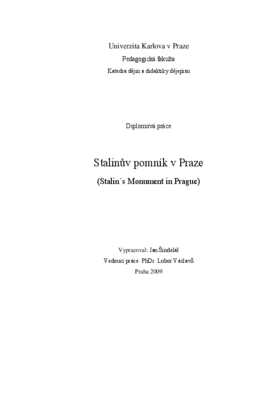Stalinův pomník v Praze
Stalin's Monument in Prague
rigorózní práce (OBHÁJENO)

Zobrazit/
Trvalý odkaz
http://hdl.handle.net/20.500.11956/25125Identifikátory
SIS: 82357
Katalog UK: 990011823950106986
Kolekce
- Kvalifikační práce [20518]
Autor
Vedoucí práce
Oponent práce
Pokorný, Jiří
Fakulta / součást
Pedagogická fakulta
Obor
Učitelství všeobecně vzdělávacích předmětů pro základní školy a střední školy - dějepis
Katedra / ústav / klinika
Katedra dějin a didaktiky dějepisu
Datum obhajoby
1. 2. 2010
Nakladatel
Univerzita Karlova, Pedagogická fakultaJazyk
Čeština
Známka
Prospěl
was unveiled on 1st May 1955 as a part of the celebration of 10th anniversary of the end of the WW2; more than two years after Stalin's death. The political situation in the Soviet block was changed after N. S. Khrushchev's speech on the cult of Stalin's personality on the XX congress of the Soviet communist party in February 1956 and also on the XXII congress in autumn 1961. The satellite states had to modify their ideology against the cult of personality; therefore also the Stalin's monument in Prague was removed in autumn 1962. Nowadays, on the monument's place there are only stairs, a promenade and a pedestal with a high metronome by V. K. Novák. Stalin's monument in Prague was destroyed after only 7 years of its existence by the same political power which built it. From the beginning the project was intensively monitored and supported by the most powerful memebers of the leading communist party, but the main political line for Soviet satellites was ordered from Moscow. The "rise and fall" of Stalin's monument in Prague is a good example of this fact.
The thesis describes one of the biggest pieces of work of the communist propaganda in the 1950's in Czechoslovakia. The Stalin's monument in Prague was a very clear example of the cult of personality, too. Its construction was a result of the post-war political situation in Europe. Step by step, the communist parties took the power in the states under the Soviet influence between years 1945-1948. After political changes in February 1948 in Czechoslovakia, the new established power wanted to strengthen its own position in the society. The propaganda was a powerful and efficient way to do it, especially in the art. The communist icons started replacing the icons of the former Czechoslovakia. The building of the Stalin's monument officially began in December 1949 as a part of the celebration of Stalin's 70th birthday. After this great introduction the construction itself started in the winter 1952. This delay was a result of two-year discussions about the concepts, used materials and planned destination; the original place wasn't suitable mainly for geological reasons. The winners of the art competition for the architectonic and sculptural concept (Švec - Štursa - Štursová) had to change their ideas according to the wishes of the members of the government committee, which was established as the...
